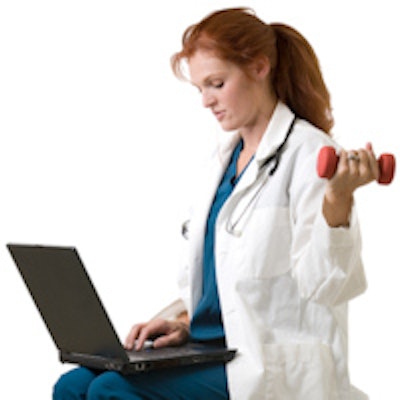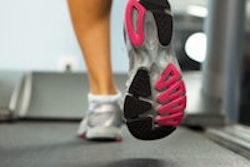
Ever feel like you're on a treadmill? Some radiologists at the University of Washington get that feeling every day, especially after exercise equipment was installed in their reading room. It's all in the name of keeping radiologists healthy by improving their physical activity, according to an article in the September American Journal of Roentgenology.
Evidence suggests that too much sitting increases a person's risk of heart disease, diabetes, and cancer, and because radiology tends to be a sedentary profession, radiologists would do well to change their work habits. There are a few technological and behavioral measures that can really help, wrote author Dr. Michael Richardson from the University of Washington.
"Radiologists spend a lot of time sitting in the dark," he told AuntMinnie.com. "We joke about our tailbones getting sclerotic because we sit all day. But it's not hard to start paying attention to your activity and making some changes to increase it."
Monitoring physical activity with a digital pedometer or a phone app can help radiologists break out of a sitting rut. Physical activity can be measured by calories used, steps or miles walked (10,000 steps, or about five miles, is the general recommendation for a single day), or the intensity of activity; pedometers vary in price from about $60 to $150 (AJR, September 2014, Vol. 203:3, pp. 627-629).
Richardson cited a 2008 study in which researchers provided pedometers to a group of 131 internists and 131 surgeons; they found that internists walked about 564 steps per hour, while surgeons walked about 536 steps per hour. To set the context: Air crew on long flights walk about 842 steps per hour, while patients with artificial hips walk about 143 steps per hour (Nederlands Tijdschrift voor Geneeskunde, Goosen et al, January 2008, Vol. 152:4, pp. 203-206).
Move more
Taking regular breaks from sitting helps as well -- although there are no guidelines as to how frequent these breaks should be to incur a benefit, Richardson wrote. Another idea is to use a standing workstation.
"The simple act of standing increases [one's energy] expenditure an extra 13% over baseline, when compared with sitting," he wrote. "The growing availability and use of standing desks suggests that they can be a major tool in reducing workplace sedentary time and obesity."
| Energy expenditure by activity | |
| Activity | Energy expenditure (% above resting) |
| Resting | 0 |
| Sitting motionless | 3.7 |
| Standing motionless | 13 |
| Chewing gum | 19 |
| Sitting while fidgeting | 54 |
| Standing while fidgeting | 94 |
| Walking 1 mile per hour | 154 |
| Walking 2 miles per hour | 202 |
| Walking 3 miles per hour | 292 |
Finally, adding purposeful exercise through the use of fitness equipment can improve health in a sedentary workplace, according to Richardson. At the University of Washington, the radiology department uses a treadmill under a standing workstation desk, as well as an elliptical trainer that fits under a sitting desk; both of these devices are used by two faculty members and by about one in five of the department's residents, he wrote.
"Users walk between one and three miles per hour for times ranging between five minutes and three hours," he wrote. "Individual step counts range from a few thousand to 15,000 per day. So far, none of our users has felt the need to shower after a treadmill session."
Richardson's department has found that the devices do not negatively affect radiologists' diagnostic performance or contribute too much additional noise to the reading room.
"Studies of office workers have shown that computer task performance while standing is not different from that while sitting," he wrote. "[As for noise], these two exercise devices add, at most, only a tiny amount to the ambient noise level in our reading room."
As for concerns about staff safety while using a treadmill or elliptical device, it's important to consider the alternative.
"I suppose someone could get hurt using an elliptical device, but having a heart attack due to a sedentary lifestyle is even more dangerous," he told AuntMinnie.com.
What's the takeaway? It doesn't take much to increase physical activity at work, even for radiologists, according to Richardson.
"Adding more physical activity to the workplace doesn't have to be a big deal -- it can be incremental," he said.




















